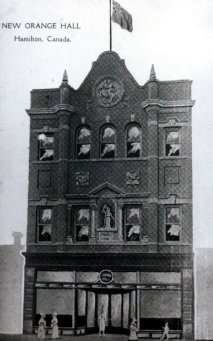22 King Street East 

CURRENT STATUS (1999)
Present Owner: Adele Sager and Simon Molka
Present Use: Financial offices, retail
stores, various tenants
Heritage Status: Listed on the City's Inventory
of Buildings of Architectural and / or Historical Interest
Locally Significant Date: Pre-Confederation
 BUILDING INFORMATION
BUILDING INFORMATION
Date Built: 1840s
Original Owner: Archibald and Thomas C.
Kerr, dry goods merchants
Original Use: Wholesale dry goods business
to 1906
Subsequent Uses: Wholesale shoes and leather
goods (John Lennox & Co., 1910-1922); financial offices; Honey Dew Coffee Shop
(1942-70); various retail stores
Previous Building on Site: Unknown, probably
none
 ARCHITECTURE
ARCHITECTURE
Size: Three-storeys
Design and Style: Neoclassical
Architect, Builder: William Thomas,
architect
Construction Materials: Brick masonry with
limestone front
Architectural Integrity: Moderate (upper
facades largely intact, except for replacement of all but four original windows)
Architectural Features: Austere but well proportioned ashlar facade with a continuous lintel under
the third storey windows and flat voussoir arches over the windows; decorative stone
cornice; eyebrow dormers; ornate molded window caps; decorated cornice appears to be
fabricated of sheet metal
The Orange Society was founded as a fraternal society in Ireland in 1795, coming to
Canada in 1830. At its peak, the organization had approximately 25,000 members, including
John A. Macdonald.
 The organization owned and operated
orphanages and other charitable institutions.
The organization owned and operated
orphanages and other charitable institutions.
The society had problems with racial and religious issues, which were deeply rooted in
Irish history. On July 12, 1690, the battle of the Boyne was fought and Prince William of
Orange defeated the Catholic James II assuring that the British throne would only be ruled
by a Protestant. In celebration of the battle, a huge parade was planned annually and
people from all over travelled to Hamilton to join in the festivities.
In 1905, the group decided to pool their resources and erect a $20,000 building to
house all lodges and associated organizations. The Orange Hall of Hamilton had two store
fronts available on the first floor. Between the stores was an entrance hall which led to
the rear of the building and to a stairway. The second floor contained two large lodge
rooms and four small anterooms. The top floor was home to the Royal Black Preceptory and
had a large drill hall to the rear.
The ornate James Street front was fabricated from pressed brick and had stone
trimmings, including a bas-relief of King William on his celebrated horse. A statue of
Justice, inscribed with the motto "Justice for All" added to the imposing
streetscape.
When the Orange Association left its Hamilton location for Toronto, the building was
used as a Portuguese social club until it was torn down.

![]()
![]() BUILDING INFORMATION
BUILDING INFORMATION![]() ARCHITECTURE
ARCHITECTURE The organization owned and operated
orphanages and other charitable institutions.
The organization owned and operated
orphanages and other charitable institutions. 